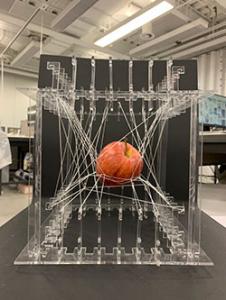10-11-2018, 04:01 PM
This is my end goal of simulation  :
:
 (or please click the attachment to see image)
(or please click the attachment to see image)
the strings in the image that holds the apple up is one continuous string that goes through multiple holes on the frame.
I chose to use digital simulation over making physical models because we want to produce a lot of different weaving patterns, say 60 distinct ones.
My question is: how to most efficiently create these web structure?
Since I'm completely new to Unity and more comfortable using Rhino,
s there anyway we can turn curves from rhino into obi-rope?
Or does it have to be done in Unity?
Btw, this is a great product!
Thanks in advance!
Po
 :
:the strings in the image that holds the apple up is one continuous string that goes through multiple holes on the frame.
I chose to use digital simulation over making physical models because we want to produce a lot of different weaving patterns, say 60 distinct ones.
My question is: how to most efficiently create these web structure?
Since I'm completely new to Unity and more comfortable using Rhino,
s there anyway we can turn curves from rhino into obi-rope?
Or does it have to be done in Unity?
Btw, this is a great product!
Thanks in advance!
Po









